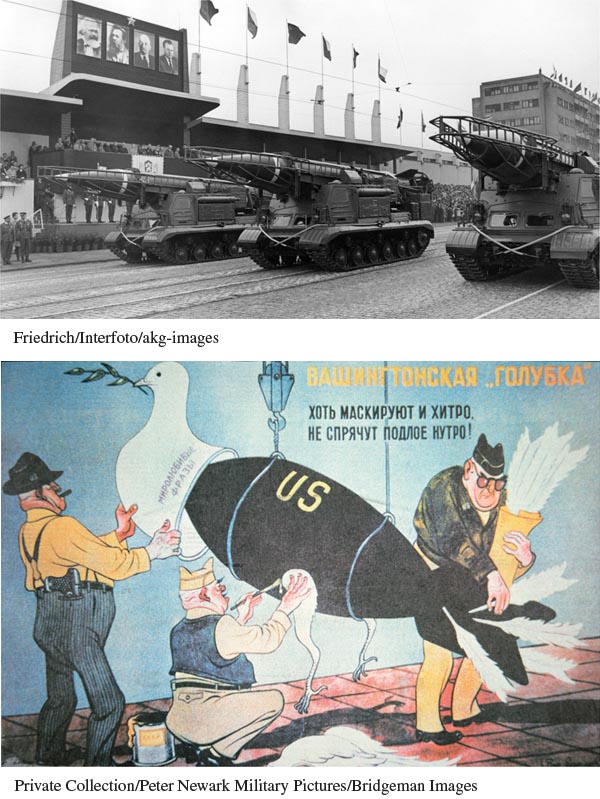A History of Western Society: Printed Page 950
A History of Western Society, Value Edition: Printed Page 913
A History of Western Society, Concise Edition: Printed Page 953
Chapter Chronology
Big Science in the Nuclear Age
During the Second World War, theoretical science lost its innocence when it was joined with practical technology (applied science) on a massive scale. Many leading university scientists went to work on top-secret projects to help their governments fight the war. The development by British scientists of radar to detect enemy aircraft was a particularly important outcome of this new kind of sharply focused research. The air war also greatly stimulated the development of rocketry and jet aircraft. The most spectacular and deadly result of directed scientific research during the war was the atomic bomb, which showed the world both the awesome power and the heavy moral responsibilities of modern science and its high priests.
The impressive results of this directed research inspired a new model for science — Big Science. By combining theoretical work with sophisticated engineering in a large bureaucratic organization, Big Science could tackle extremely difficult problems, from new and improved weapons for the military to better products for consumers. Big Science was extremely expensive, requiring large-scale financing from governments and large corporations.
Page 951
After the war, scientists continued to contribute to advances in military technologies, and a large portion of all postwar scientific research supported the growing arms race. New weapons such as missiles, nuclear submarines, and spy satellites demanded breakthroughs no less remarkable than those responsible for radar and the first atomic bomb. After 1945 roughly one-quarter of all men and women trained in science and engineering in the West — and perhaps more in the Soviet Union — were employed full-time in the production of weapons to kill other humans. By the 1960s both sides had enough nuclear firepower to destroy each other and the rest of the world many times over.

The Soviet View of the Arms Race During the 1950s and 1960s the United States and the Soviet Union (with its east European satellite allies) engaged in an all-out nuclear arms race. The battle to stockpile massive numbers of atomic weapons involved rapid scientific advance, public displays of powerful weaponry, and accusatory propaganda campaigns. On the twentieth anniversary of victory in World War II, Communist authorities in Prague, the capital of Czechoslovakia, watched a parade of the latest Soviet ballistic missiles. The Soviet cartoon depicting the United States masking its nuclear threat as the dove of peace reads, “Washington ‘Dove’— Though cleverly disguised, it does not hide its cowardly insides.”
cartoon: Private Collection/Peter Newark Military Pictures/Bridgeman Images
Sophisticated science, lavish government spending, and military needs came together in the space race of the 1960s. In 1957 the Soviets used long-range rockets developed in their nuclear weapons program to launch Sputnik, the first man-made satellite to orbit the earth. In 1961 they sent the world’s first cosmonaut circling the globe. Embarrassed by Soviet triumphs, the United States caught “Sputnikitis” and made an all-out commitment to catch up with the Soviets. The U.S. National Aeronautics and Space Administration (NASA), founded in 1958, won a symbolic victory by landing a manned spacecraft on the moon in 1969. Four more moon landings followed by 1972.
Advanced nuclear weapons and the space race were made possible by the concurrent revolution in computer technology. The search for better weaponry in World War II boosted the development of sophisticated data-processing machines, including the electronic Colossus computer used by the British to break German military codes. The massive mainframe ENIAC (Electronic Numerical Integrator and Computer), built for the U.S. Army at the University of Pennsylvania, went into operation in 1945. The invention of the transistor in 1947 further advanced computer design. From the mid-1950s on, this small, efficient electronic switching device increasingly replaced bulky vacuum tubes as the key computer components. By the 1960s sophisticated computers were indispensable tools for a variety of military, commercial, and scientific uses, foreshadowing the rise of personal computers in the decades to come.
Page 952
Big Science had tangible benefits for ordinary people. During the postwar green revolution, directed agricultural research greatly increased the world’s food supplies. Farming was industrialized and became more and more productive per acre, resulting in far fewer people being needed to grow food. The application of scientific advances to industrial processes made consumer goods less expensive and more available to larger numbers of people. The transistor, for example, was used in computers but also in portable radios, kitchen appliances, and many other consumer products. In sum, in the nuclear age, Big Science created new sources of material well-being and entertainment as well as destruction.
